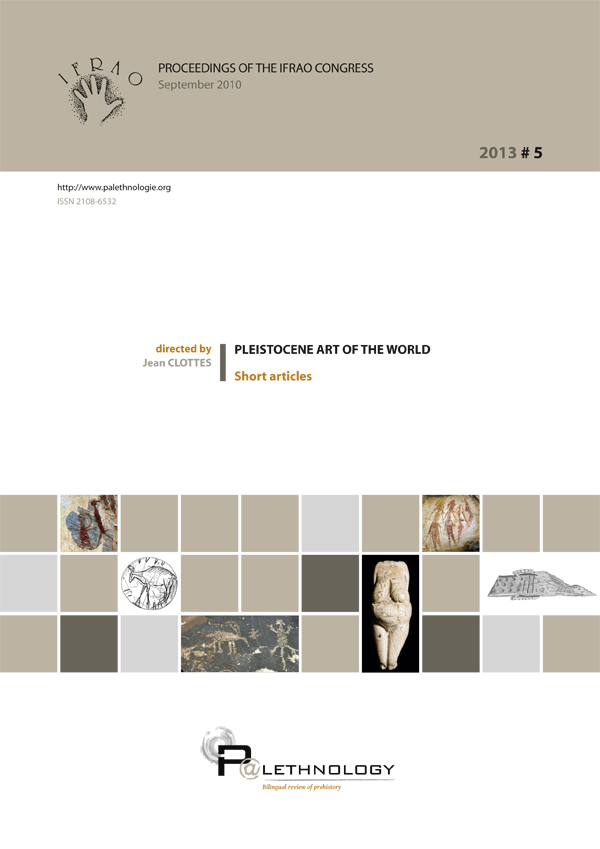Introduction to a congress that marks a milestone
Jean CLOTTES
When Robert Bednarik, following the suggestion of Giriraj Kumar, asked me to organize the 2010 IFRAO congress on Pleistocene Art of the World, I was divided by two sentiments: my enthusiasm for the subject and my apprehension of the difficulty and enormity of the task. It had to take place in Europe, where Pleistocene art is best known and most spectacular. It could very well have been in Spain, and I admit that I hesitated. Pascal Alard, in charge in the Ariège (and elsewhere…) of all that has to do with Prehistory, convinced me. He assured me that we would have the total support of his team at the Parc de la Préhistoire and that of the Ariège Department, and he was right. This aid was decisive. In early September 2010, it made possible the organization and running of the Congress, its success, with nearly 400 participants, and now, the indispensable publication of its Proceedings.
We proposed nine symposia one for each continent, plus four more on specific topics. The number of presentations (around 180) required us to organize four parallel sessions in nearby, but distinct, locations. To enable participants to pass from one to another, we had to rigorously respect the planned time frame. The presidents of the symposiums ensured this. The quality of the Parc itself (and that of the meals served…), its splendid environment, the excursions, and the final evening gala, were all a source of vivid and emotional memories for the participants,
as I have been told by many.
Finally, we received 142 publishable papers, after the presidents of the symposiums exercised their right to accept or refuse articles. The official languages of the Congress were French, English and Spanish, and the articles in this volume will be published in these three languages. Though it is perfectly legitimate, I cannot help but regret that a few French colleagues chose to publish their contribution in English. To continue in the chapter of regrets, I am also disappointed that certain participants, after having presented their work at the congress, chose not to publish in the Proceedings, preferring a more prestigious journal. In my opinion, one must choose: barring extenuating circumstances, participation in a congress should be considered as a moral commitment, rather than as a periodic means to boost a career.
The abundance of articles (and costs) prohibited their full publication in printed form. The compromise we found was to allocate two printed pages for a summary of each study, along with one illustration, and to publish the full articles, whatever their length and number of illustrations, on a CD-rom included with the printed version. The page numbering permits these articles to be cited in bibliographies. This was not as easy as it may sound, since some authors sent summaries of only a few lines, while others, more numerous, sent texts that were too long and illustrations that were impossible to fit into the allotted space. We had to negotiate and suggest reductions. To gain space, the bibliographic references, author affiliations, and even the keywords, are found only with the full articles and not with the printed summaries.
From a scientific perspective, this volume marks a milestone. As we might have expected, European Paleolithic art, portable and parietal, occupies a lot of space, with new results and syntheses of very diverse forms of this art. Africa is less well represented than we had hoped, despite the interest of recent discoveries in Upper Egypt. The three other continents made many rich contributions that provide a welcome overview of what we know of the earliest periods and especially of the uncertainties and gaps in our knowledge. We can wager that in the coming years these gaps will be filled and the recognition of Pleistocene sites will be multiplied on the four continents where they are still underrepresented.
In closing, I express my sincere gratitude to those who contributed to the success of this Congress and to the publication of its Proceedings. First, to my dear IFRAO colleages, and foremost among them, Robert Bednarik and the other presidents of the symposiums: Aline Averbouh, Enrico Comba, Valérie Feruglio, Dirk Huyge, Yann-Pierre Montelle, Giriraj Kumar, María Mercedes Podestá, André Prous, Dario Seglie and Alice Tratebas.
Without the efficient work of Pascal Alard and his team from the Parc de la Préhistoire, none of this would have been possible. Jacques Azéma, Emmanuel Demoulin, Cécile Sarrail, Myriam Cuennet, Audrey Laffont, Jean-Marie Dumora and a young intern, Nathalie Bordenave, accomplished a remarkable task. My secretary, Anne Cier, continually offered her precious aid for both the preparation and running of the conference, as well as the publication of the Proceedings.
We received full support and encouragement from the Ariège Department and its president Augustin Bonrepaux. The Ministry of Culture and Communication provided us with financial and moral support. Marc Drouet, in charge of Archaeology at the Ministry of Culture, honored us with his presence at the opening of the Congress, accompanied by Michel Vaginay, Regional Curator of Archaeology, alongside the Ariège Prefect, Jacques Billiant, who was particularly interested in our work.

